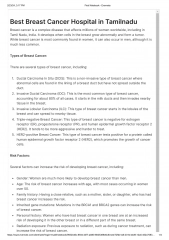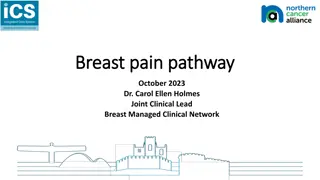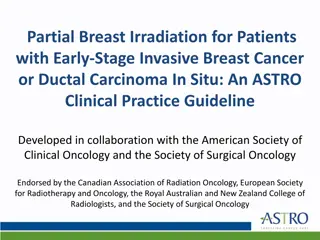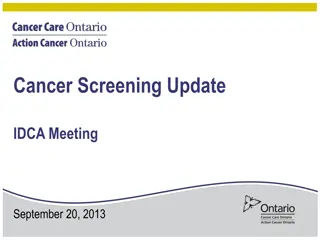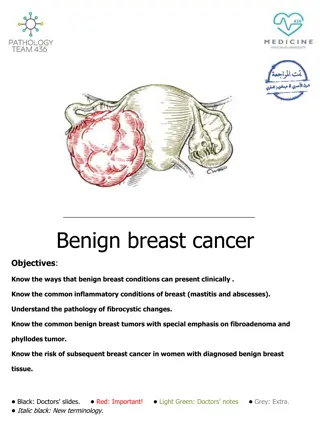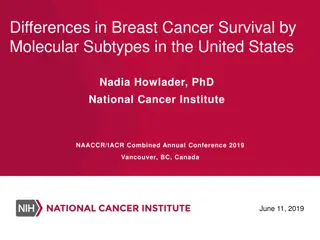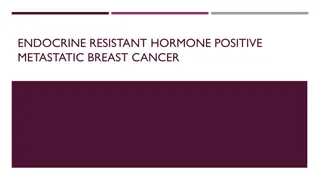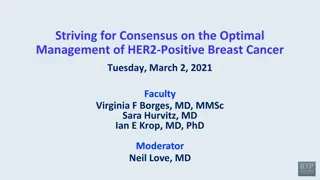Approach to metastatic Breast Cancer
Metastatic breast cancer is a significant global health concern, with millions of new cases and deaths reported. This type of cancer presents various signs and symptoms, including metastasis to common organs such as bone, liver, and lungs. Despite challenges, advancements in systemic therapies have shown improved survival rates. Treatment strategies are tailored based on tumor biology and clinical factors, typically involving systemic medical therapy like chemotherapy and endocrine therapy.
Download Presentation

Please find below an Image/Link to download the presentation.
The content on the website is provided AS IS for your information and personal use only. It may not be sold, licensed, or shared on other websites without obtaining consent from the author.If you encounter any issues during the download, it is possible that the publisher has removed the file from their server.
You are allowed to download the files provided on this website for personal or commercial use, subject to the condition that they are used lawfully. All files are the property of their respective owners.
The content on the website is provided AS IS for your information and personal use only. It may not be sold, licensed, or shared on other websites without obtaining consent from the author.
E N D
Presentation Transcript
Approach to metastatic Breast Cancer Approach to metastatic Breast Cancer Presented by : Dr. F. Boostani. MD. Medical Hematologist & oncologist
the GLOBOCAN 2020 estimates of cancer incidence and mortality produced by the International Agency for Research on Cancer. Worldwide, an estimated 19.3 million new cancer cases (18.1 million excluding nonmelanoma skin cancer) and almost 10.0 million cancer deaths (9.9 million excluding nonmelanoma skin cancer) occurred in 2020. Female breast cancer has surpassed lung cancer as the most commonly diagnosed cancer, with an estimated 2.3 million new cases (11.7%), followed by lung (11.4%), colorectal (10.0 %), prostate (7.3%), and stomach (5.6%) cancers.
Female breast cancer has now surpassed lung cancer as the leading cause of global cancer incidence in 2020, with an estimated 2.3 million new cases, representing 11.7% of all cancer cases . It is the fifth leading cause of cancer mortality worldwide, with 685,000 deaths. Among women, breast cancer accounts for 1 in 4 cancer cases and for 1 in 6 cancer deaths
Signs and symptoms breast cancer Breast mass Locally advanced disease Metastatic disease
Metastatic disease Symptoms of metastatic breast cancer depend on the organs involved, with the most common sites of involvement being the bone ( back or leg pain), liver (abdominal pain, nausea, jaundice), and lungs ( shortness of breath or cough).
Although metastatic breast cancer (MBC) is unlikely to be cured, meaningful improvements in survival have been seen, coincident with the introduction of newer systemic therapies . Median overall survival now is slightly over three years,with a range from a few months to many years .
The selection of a therapeutic strategy depends upon both tumor biology and clinical factors, with the goal being a tailored approach. Although a subset of patients with oligometastatic disease may benefit from an intensified locoregional approach, most patients with MBC receive systemic medical therapy consisting of chemotherapy, endocrine therapy, and/or biologic therapies, and supportive care measures
The primary goals of systemic treatment for MBC are prolongation of survival, alleviation of symptoms, and maintenance or improvement in quality of life,despite the toxicity associated with treatment . The median survival for MBC varies widely based on subtype of tumor, sites of metastatic involvement, and burden of metastatic disease, and some patients experience long-term survival
Disease assessment Complete evaluation for the extent of metastatic disease includes confirmatory biopsy of suspected lesions and reassessment of molecular markers, particularly estrogen receptor (ER), progesterone receptor (PR), and HER2 overexpression. This is especially important if the primary cancer was deemed negative for ER, PR, and/or HER2, since a conversion to positive could dramatically change therapy.
We further assess tumors for presence of mutations in breast cancer susceptibility gene 1 or 2 (BRCA1 or BRCA2) For patients whose tumors stemmed from mutations in BRCA1 or BRCA2, we suggest germline testing for these mutations, in view of therapeutic options (poly[ADP-ribose] polymerase [PARP] inhibitors) We also evaluate tumors for mutations in tropomyosin receptor kinase (TRK) as well as for the presence of microsatellite-high/DNA mismatch-repair deficiency
Role of repeat biopsy We advise patients with newly diagnosed, metastatic disease to undergo a repeat biopsy, which will not only establish the diagnosis of MBC, but will also allow a reexamination of receptor status . Although how these results should influence management is the subject of debate, we suggest not withholding targeted treatment based on the results of a metastatic biopsy. Results of the metastatic biopsy may,however, make targeted therapies available for those whose initial biopsy did not display hormone receptor or HER2 positivityThe rates of discordance of receptor status between the primary and metastatic lesions vary, but typically range between 5 to 30 percent .
ASCO reported its guidelines about the role of rebiopsy, suggesting that it should be performed, but there is no prospective evidence that changing treatment based on the information of the metastatic biopsy affects outcomes. Neverthess, per this guideline, in case a biopsy is performed and discrepancy is found between the primary and metastatic tumors, information from the metastatic setting should be utilized for management decisions.
ESMO guideline acknowledges the lack of prospective trials evaluating change in treatment based on immunohistochemical discrepancies between primary and metastatic tumors, but recommends consideration to utilize targeted treatment (endocrine therapy or antiHER2 therapy) if the receptors are positive in at least one of the biopsies, regardless if in the primary or metastatic settings. Our strategy is consistent with the ESMO guideline, although we recognize that in the setting of limited data, other experts may adopt a different approach.
Prediction of response Prediction of response Hormone receptor status and HER2 overexpression are the most important predictors of treatment response in patients with MBC. Patients who are carriers of genetic alterations in breast cancer susceptibility genes 1 or 2 (BRCA1 or BRCA2) are more likely to respond to PARP inhibitors. Thus, we suggest germline testing for these mutations in patients with advanced breast cancer, as per NCCN guidelines. In regards to response to chemotherapy, consistent predictors of poor response are progression with prior chemotherapy for advanced disease, relapse within 12 months of completing adjuvant chemotherapy, poor performance status, and multiple disease sites, especially visceral involvement
Markers of increased cellular proliferation such as high S-phase fraction by flow cytometry, increased uptake of radiolabeled thymidine, and immunohistochemical staining for the proliferation antigen Ki67 are all associated with higher chemotherapy response rates . By contrast, breast cancers that overexpress gp170, a drug efflux pump that mediates multidrug resistance, or have a mutated tumor protein p53 (TP53) gene may be less likely to respond to chemotherapy.
SYSTEMIC TREATMENT SYSTEMIC TREATMENT Patients with visceral metastases (especially if rapidly progressing) and/or a short disease-free interval generally have an aggressive phenotype, while patients with soft tissue and bone metastases have a more indolent phenotype. Hormone receptor status and human epidermal growth factor receptor 2 (HER2)overexpression are important in estimating prognosis and the likelihood of response to therapy. Chemotherapy is indicated for hormone-insensitive MBC ( patients with hormone receptor-negative breast cancer and those with hormone receptor positive breast cancer who have become resistant to endocrine therapy).
POly(ADP-ribose) polymerase (PARP) inhibitor therapy is only appropriate for patients with breast cancer susceptibility gene 1 or 2 (BRCA1 or BRCA2) mutations, and is used after progression on chemotherapy in such patients. patients with tropomyosin receptor kinase (TRK)-positive cancers that have progressed on other available options, we offer treatment with TRK inhibitors. Those with microsatellite-high/DNA mismatch-repair deficiency may benefit from pembrolizumab, after progression on other treatment options
Hormone receptor-positive, HER2-negative patients Hormone receptor-positive, HER2-positive patients Hormone receptor-negative, HER2-negative patients Hormone receptor-negative, HER2-positive patients
Sequential single agents versus combination chemotherapy single-agent chemotherapy, used in sequence, is preferable to combination chemotherapy, since the single-agent chemotherapy is reasonably likely to induce palliation with fewer side effects, and no studies have demonstrated an overall survival (OS) benefit for the combination chemotherapy as long as both drugs are available in sequence.
Combining treatment modalities combining chemotherapy, biologic therapy, and/or endocrine therapy might have additive efficacy, but it might also lead to increased toxicity. PARP inhibition for BRCA carriers For patients with metastatic, HER2-negative breast cancer with germline breast cancer susceptibility gene (BRCA) mutations who have previously been treated with chemotherapy in the neoadjuvant, adjuvant, or metastatic disease setting (and who have also received at least one line of endocrine therapy, if they have hormonereceptor- positive disease), we suggest an oral inhibitor of poly(ADP-ribose) polymerase (PARP)
Osteoclast inhibitors Patients with bone metastases should be treated with osteoclast inhibitors (bisphosphonates or receptor activator of nuclear kappa-B [RANK] ligand inhibition), as these agents have been shown to reduce the risk of skeletal- related events such as fractures, the need for surgery or radiation to bone, spinal cord compression, and hypercalcemia of malignancy
MONITORING THERAPY Careful assessment of the response to therapy will assist in decisions for duration of treatment and in selection of subsequent treatments. However, the best approach for monitoring patients with MBC is not well established. Overall survival (OS) is the gold standard for comparing therapies, but it requires prolonged follow-up and may be diluted by the effects of subsequent treatment
Tumor markers Serial assay of serum tumor markers ( cancer antigen [CA] 15-3 and CA 27,29 both products of the mucin 1 [MUC1] gene, and carcinoembryonic antigen [CEA]) can aid in response assessment, particularly if disease sites are not assessable by usual criteria. (ASCO) expert panel suggest that it is reasonable to evaluate CA 15-3, CA 27.29, and CEA initially in patients with metastatic disease.
Circulating tumor cells C Detection of circulating tumor cells (CTCs) in blood samples of patients with MBC ( 5 CTCs) has been shown to be a predictor of PFS and OS . However, the role of CTCs in the monitoring of patients remains controversial. Therefore, we agree with ASCO expert panels, which have concluded that measurement of CTCs should not be used to influence treatment decisions in metastatic disease at this time
DEFINITION OF TREATMENT FAILURE clinical deterioration during treatment (increasing disease-related symptoms, intolerable treatment toxicities, declining performance status) Evidence of new metastases Increasing size of previously documented metastatic lesions
PROGNOSIS Clinical factors that predict the rate of progression and survival include the interval between initial therapy and relapse, the number of metastatic sites, the presence or absence of visceral involvement, performance status, and biologic markers. The role of these factors is discussed separately


